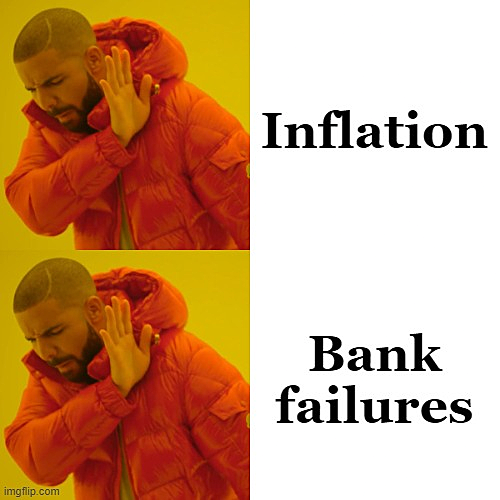It seems hard to believe that 2023 is already three months old. A lot has happened since the end of last year dragged around, the crypto sector bruised and bloodied from a brutal 12-month bear market.
Now, though, the picture is much brighter. Still mixed, for sure; old problems remain, and new ones are taking shape. But it feels like the nature of those challenges, and the role that crypto and Web3 will play in the world, are becoming clearer by the day.
Here are some of the biggest highlights and low points of the year so far, courtesy of your frens at Ruby.Exchange.
Bitcoin Bottoms And Rallies Hard
After putting in a bear market low around $15,500 in late November 2022, BTC bumped along in the $16-18k range for the rest of the year. That changed abruptly almost as soon as 2023 got under way. Bitcoin reclaimed the $20k line within just two weeks, and hasn't looked back since.
The first major resistance hurdle at $25,000 followed two months later, with BTC pulling above the 200-week moving average. It closed out the quarter at $28,500, not far from a nine month high and almost 100% off the bottom.
NFTs Prove Inordinately Popular
Some of that demand for bitcoin has come from an unexpected source. NFTs have been one of the stand-out success stories of 2021 and 2022, and show no sign of going out of fashion. Now, Bitcoin has its own NFTs, courtesy of the Ordinals Protocol.
Bitcoin Ordinals are so called because they rely on Ordinals Theory, a system for numbering every Satoshi sequentially. Together with the Segregated Witness (SegWit) and Taproot updates to the Bitcoin Protocol, this allows users to attach information to a single, specific Satoshi. Moreover, there's space in the witness data section of each block to include up to 4MB of storage for the Ordinals "inscription"—meaning Ordinals are 100% on-chain.
This isn't the first time users have created NFTs on Bitcoin, but it has proven more user-friendly than other approaches, and incredibly popular. Over 640,000 Ordinals have already been created, including the predictable and inevitably valuable Bitcoin Punks.
Ordinals are also controversial, taking Bitcoin away from its original purpose of acting solely as P2P cash, and adding bloat to the blockchain. Average block size has soared from around 1.2 MB at the start of the year to 2 MB now.
NFTs in general have remained popular, thanks in part to new marketplaces. Blur, which launched in October 2022, has grown rapidly and has now flipped OpenSea as the venue with the greatest trading volumes.
When Crypto Is Outlawed, Only Outlaws Will Use Crypto
The big narrative in crypto-regulatory circles has been Operation Choke Point 2.0: The name given by the crypto community to the concerted, coordinated effort to hamstring crypto adoption and shut down crypto services, at least in the US. Altogether, it adds up to a less-than-pretty picture.
Exchanges have been a natural target. There's the SEC's Wells Notice (which is typically followed by enforcement) served against Coinbase, arguably the most legitimate, compliant, and regulation-aware organization in the space. Kraken settling its suit over staking products with the SEC for $30 million. Further SEC opposition against Binance.US over its $1 billion purchase of bankrupt crypto lender Voyager. And then last week's news of the CFTC going after Binance with all guns blazing.
There's the slew of enforcement notices sent to DeFi projects, especially those that stick their head above the parapet and ask to work with the SEC to ensure compliance.
There are the persistent reports of debanking for blockchain businesses, which are finding it harder to access traditional payment rails—often without warning, explanation, or due process.
And there is the White House's latest Economic Report, which was scathing of crypto assets and uncomfortable with the concept of decentralization—evidenced by the awkward phrasing: "Despite Ethereum’s switch to proof-of-stake, Bitcoin has not announced plans to make a similar change."
Bitcoin Steps Up As The Ultimate Hedge
So why is bitcoin staging such a stellar turnaround when the regulatory landscape is so bleak? Well, it may have something to do with the far bigger problems that are coming to a head in the financial sector.
On March 10, Silicon Valley Bank became the second-largest bank to fail in US history. Signature Bank and Silvergate followed. These three were considered to be "crypto friendly" banks, and critics were quick to associate their collapse with the faltering digital asset markets, but there was more to the picture than that—as proved by the fall of Credit Suisse and forced buyout by Swiss banking giant UBS shortly afterwards. Deutsche Bank, another bank deemed to be of globally systemic importance, is rumored to be in trouble, too.
The new banking crisis is at least partly of the Fed's making. The story goes something like this:
Back in the Global Financial Crisis the Federal Reserve printed trillions of dollars. During Covid it printed a few trillion more. One way or another, most of that money ended up in the banks, who put a lot of it in long-dated government bonds. That's a smart move when interest rates are expected to stay low, but interest rates didn't stay low, because printing trillions caused inflation, necessitating rate hikes. Bond prices (which have an inverse relationship to interest rates) dropped accordingly, and banks found themselves underwater.
All of this was, broadly, hidden from the public because banks' accounting allows them to value these assets at the price they were bought for, not what they can be sold for right now. But as soon as customers do something selfish and unreasonable like ask to withdraw their own money, the banks are forced to sell those assets and crystallize their losses.
The solution to this pickle is to drop interest rates and print more trillions to bail the banks out. The only problem? That would also push up inflation.

TL;DR:
- The Fed now has a choice: Protect the US dollar from high inflation or save the banks and bond markets.
- The bond markets are how the government funds itself.
- Guess which the Fed will sacrifice?
- Guess too, which asset class allows traders both to move money entirely out of the conventional financial system and to hedge against high inflation?
- Now guess which set of promising financial technologies are seeing increased opposition, without congressional oversight?
The seeds of the current financial crisis were sown in the last, as multiple rounds of QE from 2008-12 and 2020 came home to roost. Bitcoin's current strength was built in its recent pain: With no bailouts and no safety net, there was no place to hide. The free market treated BTC and crypto to a dose of brutal, and practical, honesty. It wasn't fun, but it was fast. One year from peak to trough, job done.
Now, bitcoin is in a strong position to soak up billions of dollars from retail traders and institutional investors who want exposure to an asset class that is immune to banking collapse and resistant to inflation. The fact that the Fed has slowed or even paused its rate rises to avoid breaking any other banks only helps the case for risk assets, including crypto.
Kwon Gets Pinched
While the SEC and other regulators are guilty of overreach, there are plenty of legitimate targets for law enforcement, and the cleanup operation continues.
Two weeks ago, Do Kwon—founder of the world's least stable stablecoin, TerraUSD (UST)—was arrested in Montenegro. The collapse of the Terra/LUNA ecosystem saw the destruction of $60 billion in value in May last year. US prosecutors have announced charges against Kwon including securities fraud, wire fraud, commodities fraud, and conspiracy.
Since his arrest just before Christmas last year and release on $250 million bail, Sam Bankman-Fried has not been a model citizen, either. He has been accused of using VPNs and encrypted messaging apps to contact former associates from FTX and Alameda. After narrowly avoiding a return to jail, his internet access has been severely restricted.
BUIDLers BUIDL
Bear markets are always a good time for builders, and developers have capitalized on Ethereum's successful Merge last year. The next major update to Ethereum will be the "Shapella" (combined Shanghai and Capella) upgrades. Once this goes live on April 12, users will be able to unstake ETH from the staking contract for the first time since December 2020.
One of the biggest stories in L2 circles has been the interest in scaling solutions based on zk-rollups. Polygon released its zkEVM mainnet in beta, enabling the deployment of more secure and scalable dApps that are not subject to the delays and downsides of optimistic rollups. Numerous other platforms and companies are also developing zero-knowledge solutions, including SKALE.
Ruby Launches New Tech
Ruby.Exchange has continued to add features:
- Our February Core Update saw a major website overhaul, optimization for the mainnet bridge, and various improvements to Metaport
- The ability to revoke contracts
- A bug bounty
- Listing CryptoBlades' $SKILL token
- Charting and indicators
- Clet name service integration
Don't forget (especially in the context of a banking crisis) that Ruby supports USDP, USDC, USDT, and DAI, and allows efficient stablecoin-to-stablecoin swaps. Moreover, SKALE's gasless architecture means that once funds are on the Europa Chain, they can be moved anywhere in the SKALEVERSE, quickly and with zero cost.
2023 has got off to a blazing start, and we can't wait to show you what's next for Ruby—as well as looking forward to seeing new developments in the wider crypto world!
Join us on Discord, follow Ruby on Twitter, and subscribe to our blog for regular updates.






